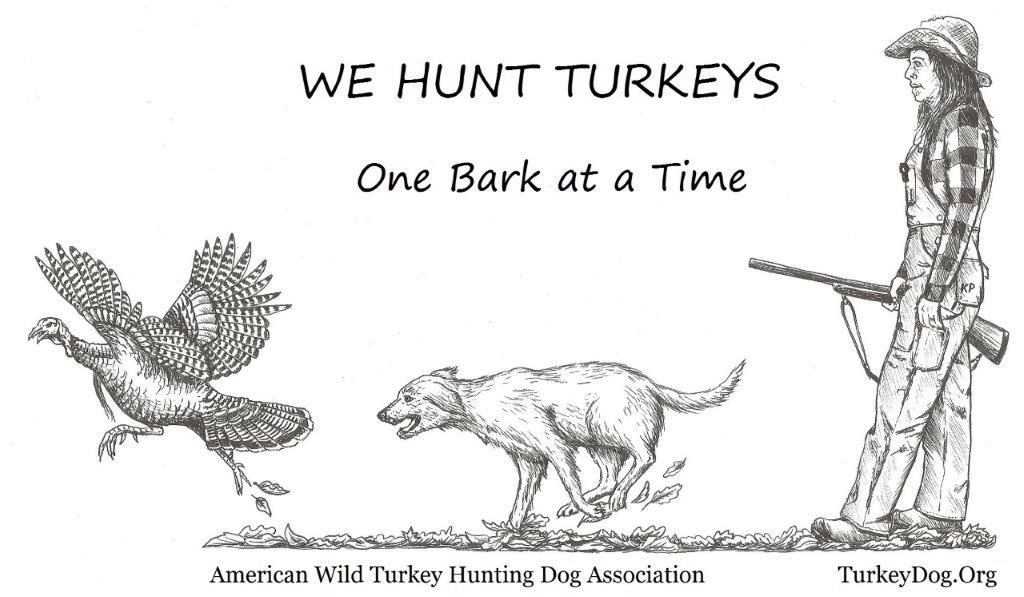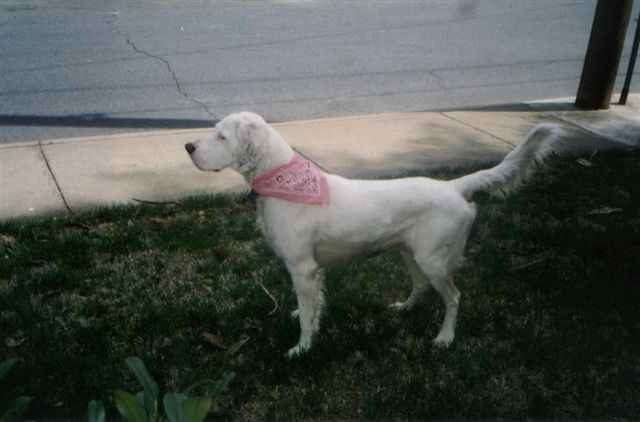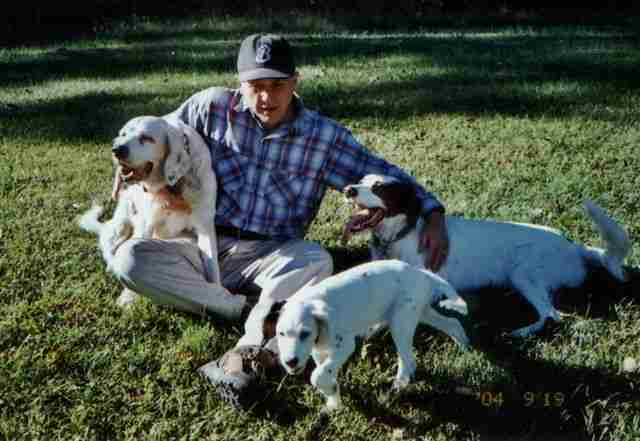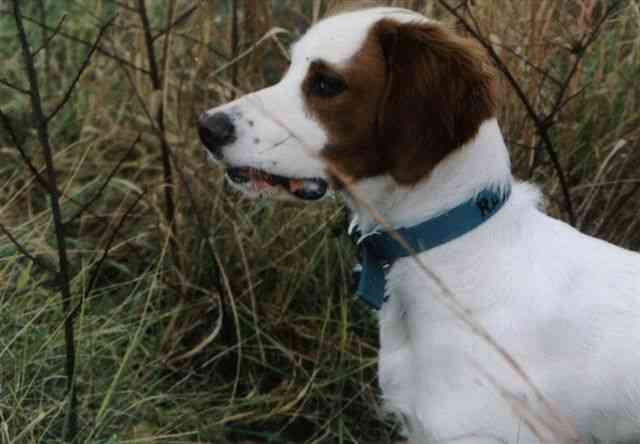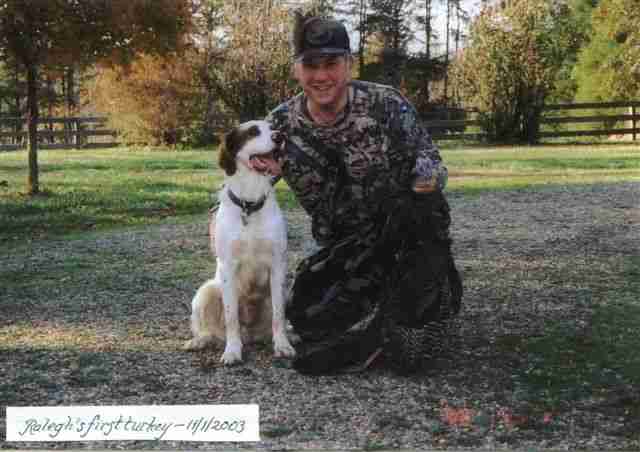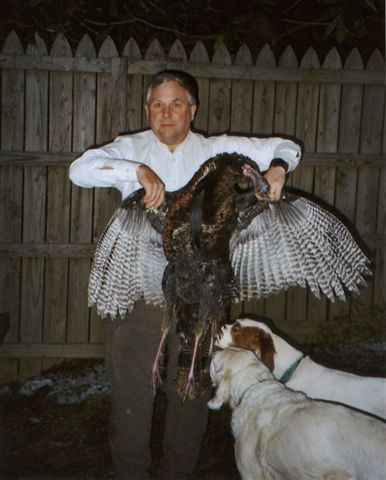|
IN MEMORIAM--DRAKE
March 21, 1991-August 1, 2006 Descriptions of the pictures, from left to right: (1) Drake, aged 6, Spring, 1997. (2) Drake (aged 13), Ralegh (aged 4) and Hawkins (aged 4 months), October, 2004. (3) Ralegh, aged 2, Fall, 2002. (4) Ralegh with his turkey, November, 2003. (5) Drake and Ralegh examining a turkey, December, 2002. The address was in town, and we pulled into a driveway off a wooded street in the west end. The brood bitch was the family pet, a purebred Llewellin from North Carolina. Through an oversight, she had never been registered, so now neither she nor her litter could be. Her mate was a big, bold, registered Llewellin from Fauquier County, one of the stalwarts of a hunting club up there, a professional hunter. She introduced herself to us in the kitchen, with the casual elegance of a well-behaved setter. The puppies bounced in right behind her, two little balls of white energy, a male and a female. We had a brief skirmish over the preferred sex, but this was resolved in my favor when the lady of the house informed us she wished to keep the little female. The male was ours for the taking. The little male was almost pure white, practically the image of Belle, with one obvious exception: His right eye was a bright blue. For a show dog, this would have been a tragedy, but we were not show people. In fact, we both agreed that his peculiar mutation made him look jaunty and a little piratical. With that and his English heritage, his name was a natural: He would be Sir Francis Drake. From the first, Drake was a joy. He was beautiful, he was sweet-natured, he was unusually intelligent. When we brought him out of the car, he came as a conqueror, and the family fell at his feet. The only cloud in our lives was that Belle was not up to a ball-of-fire puppy, so we had to watch out for her. Sadly, she was too old and sick to teach him. The years went by. Belle passed gently on. One daughter went off to college, then the other. Boyfriends came and went, and finally there was a husband. With every passing day, Drake grew more a part of our lives. We used to joke that we could never divorce, since we could never resolve custody of Drake, and there was more truth to it than jest. As he grew, his beauty grew with him, and his maturity found him one of the most beautiful setters we had ever seen, not to mention the sweetest and smartest. He was big, bold, muscular, deep-chested and nosy, with a natural quarter and sharp senses. In the woods, his eyes were keener than mine, and his nose was positively supernatural. Once he lived through the "terrible twos", his discipline was perfect. As my law partner commented: "Drake's not really a dog—he's more like an artist's conception of a dog." A few times, I hunted Drake on quail, but this was always out of town and purely occasional, certainly not enough to satisfy him or give him the finish he deserved. Then, one year, I was introduced to hunting turkeys with a bird dog. I was hooked. It took a season or so, and, for the first few years, Drake stayed home maybe half of the time. He flushed his share of called birds, but, as he always has, he learned from every mistake. By his fifth year, if I went out after turkeys, so did he. By the time the camo jacket left its hook and the little single-shot gun left the cabinet, Drake would be at the door, whining and gamboling with anxiety to go. These were the glory years, golden seasons of autumn days, following Drake as he coursed the woods like a god, calling, even shooting a few birds. But, increasingly, it was not the kill that thrilled me, it was the chase. The sight and sound of a flock being flushed, the rush of wind over heavy black wings, the pang of a crisp fall day, these were the essence of the hunt. And, above all, the sight of my faithful partner, flushing the birds, then returning to curl up at my feet at the base of a tree, quivering with anticipation under his cover of see-through camo mesh, always alert, watching with his smiling setter's eyes, but never making a move or a sound until the little rifle cracked. At the shot, I would snatch off his cover, and he would bolt off to hunt the dead bird. Over and over repeated, the story never grew old, the excitement never dimmed. A ritual developed, with Drake's getting the first slice off the breast of the fall-killed bird. But even for a god, time refuses to stand still. Gradually, I came to realize that the hills that had seemed so insignificant for him a few years ago were beginning to wear him down. One warm fall day, I had to force him to pace himself, even to the point of stopping occasionally to call without a flush. He was still a god, but I knew that he would not last forever. I began to consider the alternatives. If he could not live forever, we must give him a son to carry on. At nine years old, Drake presented us with a fine litter of seven surviving puppies, and, by their fifth week, my wife had settled on her pick: A tiny little vision of his father, with symmetrical orange ears and spectacles around his eyes, huge paws and the bright boldness we knew so well. Like his father, he was an English adventurer, so the name needed to reflect it. The original Drake had no son, so we pondered a worthy namesake for this son of an Elizabethan sea dog. This one would be Sir Walter Ralegh. With the quiet grace that he always showed, Drake adjusted to the new puppy, and, as time went on, they became almost a team, despite the difference in their ages. For a year or so, Drake remained my turkey dog, with the puppy straining to go along. As Ralegh grew big, strong and swift, Drake began a slow decline from maturity into old age, and gradually Ralegh took over in the field. Over the years, Drake faded like an old photograph. His hearing started to fail, then his eyes became cloudy and his back legs became stiff and shriveled from arthritis. But his heart and lungs were still good, his coat as lustrous and full as ever, and his personality never failed him. He could no longer hear commands, and he could not hunt or even run around in the woods by himself, but he was still Drake. One night in the back yard when we were away, he tangled with a coon, and it took a night at the emergency vet to patch him back together. A few months later, a trespassing possum bit him inside the mouth, and he almost bled to death before we realized that the bleeding had not stopped, he was just swallowing it. All in all, he had suffered numerous injuries. In addition to the coon and the possum in his last years, he had been bitten on the muzzle by a golden retriever, spurred in the face by a big gobbler and almost killed by a stick he ran into his neck. Through it all, he never complained, never flinched, never failed. The time he ran the stick in his neck, he had seven steel staples in his throat, but six days later he was back in the woods. In his fourteenth year, Ralegh presented Drake with a grandson, little Sir John Hawkins, a diminutive black and white ball of fire. Once again, Drake took the little newcomer in stride, and it was some time before the puppy would sleep anywhere but cuddled next to Drake. Ralegh became jealous and began to beat the old man up in a conflicted and inconsistent show of dominance. Finally, we kept them apart most of the time. This was OK with Ralegh, as Hawkins was around to entertain him, and it appeared to be OK with Drake, who now stayed in the house most of the time. When we took them running, we had to watch Drake to make sure he didn’t wander off, since he didn’t see well and couldn’t hear commands. Once, in September of 2004, when I took the three of them on an outing in the woods, we lost Drake. I had been carefully watching the puppy and just counting on Drake to do as he had always done. Not this time. We had gone down a hill to the river, then turned around and come back up. When I had last looked, Drake was trailing a few yards behind, and I felt free to concentrate on the puppy. At the top of the hill, Drake was nowhere to be found. I called, and both young dogs and I scoured the countryside looking for him, without result. For three days, we and a group of friends searched for him, putting ads at the SPCA, checking with the neighbors and spending hours in the woods, but we found no trace of him. For three nights, I had nightmares in which my beloved old dog was beset by coyotes, bears, wild dogs, cougars and who knows what else, and tortured by hunger and loneliness. On the fourth day, a call came out of the blue—he was found. A workman had found him in an old, disused chicken coop on a farm a couple of miles downriver. I had not realized how time and arthritis had ravaged his legs, but when I went to get him, it was obvious what had happened. His tired old legs wouldn’t pull him up the hill, so he went along the contour in the general direction we had taken. When he had realized he was truly lost, we found the best shelter he could and waited for the end, whatever that would be. His loss had meant sadness, and his return brought joy. But somewhere deep inside I wondered whether it would really have been better had he just passed away in the outdoors he had always loved. After this, the decline continued, and he rarely left the house except to walk to my office on cleaning days. In the fall of 2005, he developed a nasal infection that he could not shake, and it tormented him (and us) to the day he died. All the ministrations of the vet and modern pharmacopia provided no relief. How cruel is age. For a creature who had never been sick a day in his life to spend his last months with a debilitating and humiliating runny nose seemed almost too much to bear, as he grew ever more feeble and withdrawn. Still, through it all, through the snot and the tottering gait and the deafness and the cloudy eyes, he always retained the traces of his gentle dignity. We knew it was only a matter of time, but we would help him fight as long as we could. July turned over into August, and Charlottesville sweltered in the hottest days of the summer of 2006. The cleaning ladies were coming, and I had to take Drake to the office. It was only four blocks on level ground, but this day was not the same. Twice along the way, he had stopped, as it the effort of walking were simply too great. By the time we reached my office, he could not even try to climb the stairs. Once upstairs, he lay in front of the air conditioner, gasping for breath. I rushed him to the vet and left him for emergency treatment. A little while later, the vet called. Drake had a tumor on his spleen which had ruptured and was bleeding internally. He had lost so much blood that his body was starved for oxygen. They had stabilized him with oxygen and subcutaneous fluids, but the time had come to face the facts. This was a condition common in old dogs, and it had only one end. Had he been five years younger, surgery might have been an option, but not at his age. No matter what they did, he would never recover, he could never come home. In a cruel irony, even at this last pass, his heart and lungs were still strong. The two of us went to vet’s to say goodbye. They had told us that Drake had been sedated, and, when the door opened in the examining room, we expected the young vet. Instead, in walked Drake, unsteady and panting, old, feeble and sick, but unmistakably the noble creature who been a part of our lives for so long. It was obvious that he was comforted by our presence, even though his shortness of breath and anxiety made him restless. Caroline carried on as long as she could while the vet went through the motions of explaining the options that everybody already understood meant only one thing. When the time came, she went outside. I cradled his old head as the vet and his assistant administered the poison. The plan was to put half of it in his front leg, let him go to sleep, then put the rest in his back leg. As the chemical entered his system, he grew limp and finally drooped onto the floor. The ultimate rightness of the decision was obvious to me when the vet couldn’t find a vein in his hind leg to finish the dose. I left when I realized it was over. His breathing slowed and his heart wound down. He had faded peacefully away, without a whimper, without a struggle. It was time, and it was right. He was gone. Since that day, hardly an hour has gone by that I haven’t thought of him. Mostly, what comes to mind is not the speed and grace, not the beauty and the dash, not the great nose and even greater discipline and training, not even the deep understanding so plain in those off-color eyes. When I think of him, I mostly remember the gentleness, the dignity, the nobility that he wore like a mantle. Never have I seen his like and never will again. Last Sunday, I thought of him while listening to the preacher’s sermon, and it struck me what Drake really means to me. What is such a perfect creature, perfect in so many ways, but the embodiment of unconditional love. Surely such a creature is the ultimate proof of a beneficent God. Frederick
W. Payne, Esquire Payne & Hodous, LLP 412 East
Jefferson Street, Charlottesville, VA. Back to Llewellin
page.
|
| Home | About Us
|
Books
|
Breeds
| Classifieds
| FAQ
|
History
| Kit
Shaffer Legislation | Links | Scratchings | Spring | Stories | Tales | Shop in the Store Members are invited to send pictures of yourself and your dog, with a short story like these: Carson Quarles | Earl Sechrist | Frederick Payne 1 | Frederick Payne 2 | Gary Perlstein | Gratten Hepler | Jon Freis 1 | Jon Freis 2 | Larry Case | Marlin Watkins 1 | Marlin Watkins 2 | Mike Joyner | Mike Morrell | Parker Whedon | Randy Carter | Ron Meek 1 | Ron Meek 2 | Tom McMurray | Tommy Barham 1 | Tommy Barham 2 Members Only: Hall of Fame | Members | Museum | Studies | and the States KY | NC | NY | OH | ON | PA | TN | VA | WI | WV 2006 - 2025 American Wild Turkey Hunting Dog Association All Rights Reserved Permission to copy without written authorization is expressly denied. |
